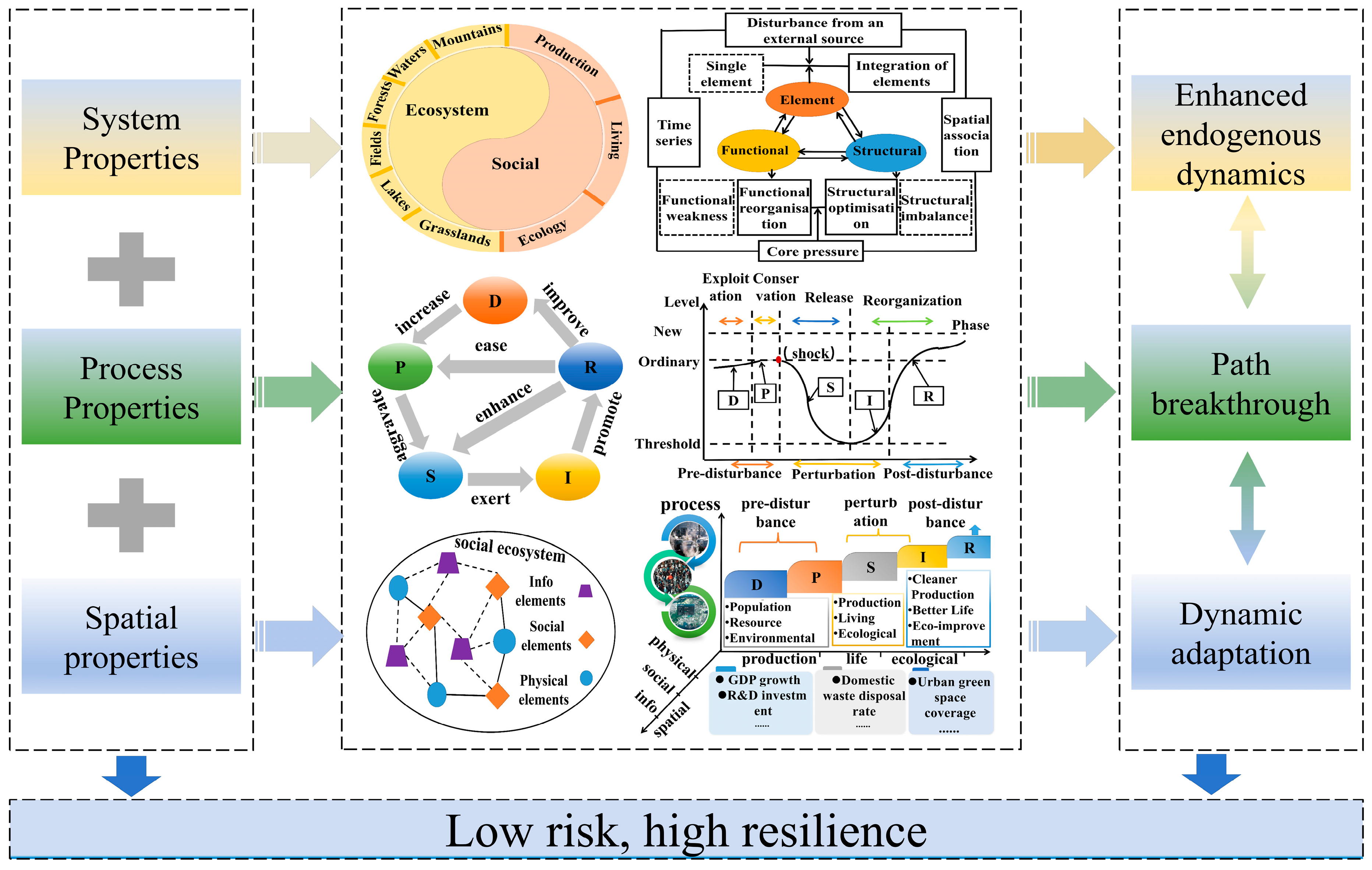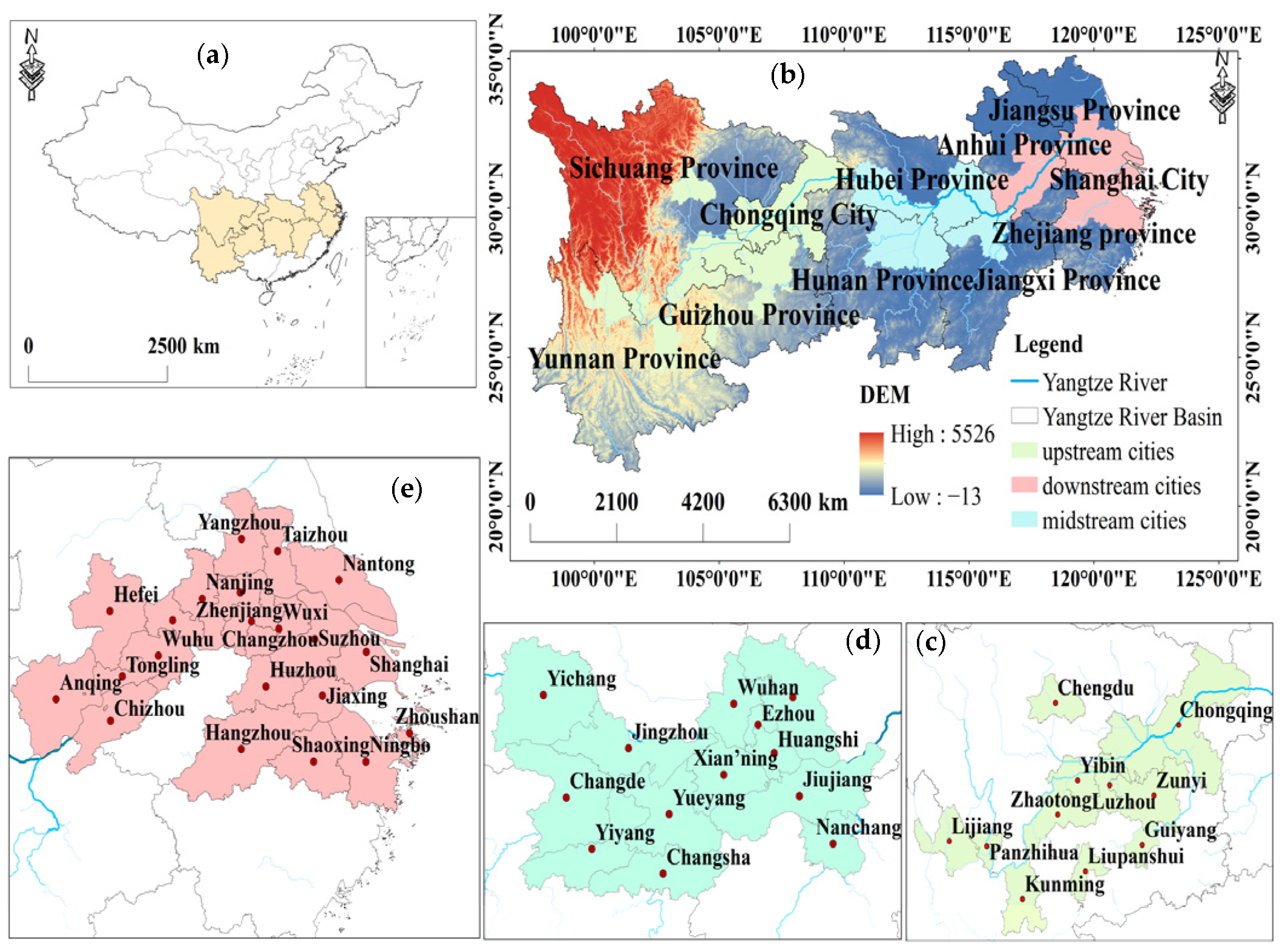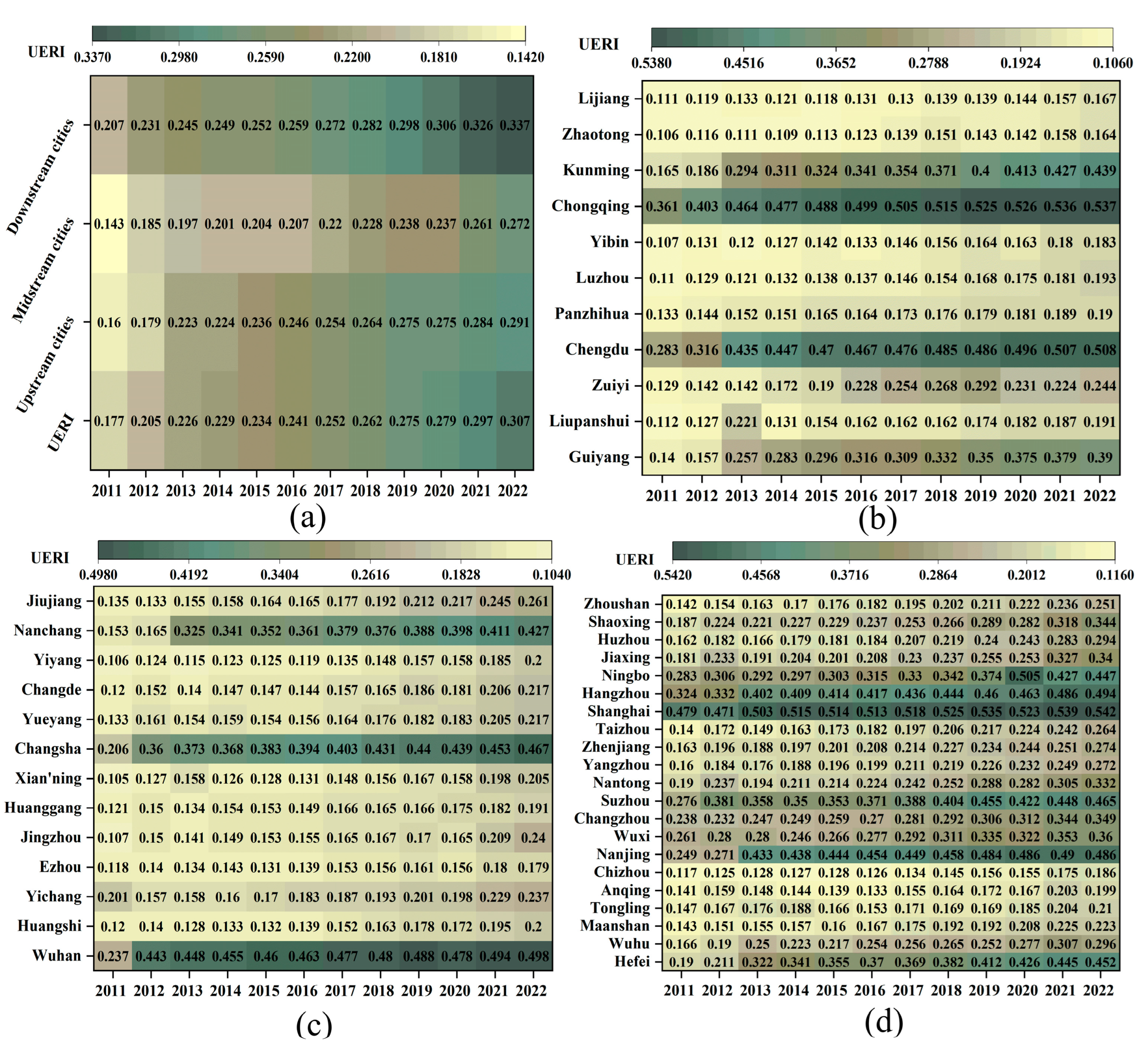Differential Evaluation of Ecological Resilience in 45 Cities along the Yangtze River in China: A New Multidimensional Analysis Framework
Abstract
:1. Introduction
2. Theoretical Framework
3. Methods
3.1. Construction of the UER System
3.2. Study Area
3.3. Data Sources
- (1)
- the China Urban Statistical Yearbook, 2011–2022 (https://navi.cnki.net/knavi/yearbooks/YZGCA/detail, accessed on 18 March 2024);
- (2)
- China Urban Construction Statistical Yearbook (https://navi.cnki.net/knavi/yearbooks/YCJTJ/detail, accessed on 18 March 2024);
- (3)
- China Environmental Statistics Yearbook (https://navi.cnki.net/knavi/yearbooks/YHJSD/detail, accessed on 18 March 2024);
- (4)
- National Economic and Social Development Bulletin of the municipalities
- (1)
- the National Earth System Science Data Center (http://www.geodata.cn/, accessed on 20 March 2024);
- (2)
- Digital Elevation Model (DEM) data (30 m resolution) from Geospatial Data Cloud (https://www.gscloud.cn/, accessed on 20 March 2024);
- (3)
- NDVI from the Resource and Environmental Science Data Platform (https://www.resdc.cn, accessed on 20 March 2024).
3.4. Research Methods
3.4.1. Entropy Weight TOPSIS Method
- (1)
- Standardize positive, negative, and moderate indicators of the raw data utilizing the extreme variance method:
- (2)
- Entropy method for calculating indicator weights
- (3)
- Determine the positive and negative ideal solutions, and calculate the distance of each indicator from these ideal solutions:
- (4)
- Calculate the closeness of each metric in relation to the ideal solution:
3.4.2. Kernel Density Estimation
4. Results
4.1. Temporal Evolution of UER
4.2. Spatial Distribution of UER
4.3. Trends in UER
5. Discussion
5.1. Comparison of Previous Research
5.2. Research Insights and Contributions
6. Conclusions and Outlook
6.1. Conclusions
- (1)
- The UER along the Yangtze River exhibits a three-stage progression: initial gradual improvement, sustained development, and rapid growth. While UER has advanced, significant room for enhancement and further development remains.
- (2)
- Although the UER trend is consistent across upstream, midstream, and downstream cities of the Yangtze River, significant spatial differences exist, represented by cluster distribution patterns. The downstream region demonstrates the highest UER. City-level analysis indicates that provincial capitals and municipalities along the Yangtze River exhibit superior UER, yet overall development remains uneven. Midstream cities display a more significant “Matthew effect” in UER, indicating insufficient momentum for coordinated UER development.
- (3)
- Kernel density estimation results suggest a gradual reduction in the absolute UER gap along the Yangtze River. This trend points to a decreasing city polarization and strengthening intercity connections, reflecting an increasing focus on regional synergistic development.
6.2. Future Outlook and Deficiencies
Author Contributions
Funding
Data Availability Statement
Conflicts of Interest
Abbreviations
References
- Zhong, S.; Wang, M.; Zhu, Y.; Chen, Z.; Huang, X. Urban expansion and the urban-rural income gap: Empirical evidence from China. Cities 2022, 129, 103831. [Google Scholar] [CrossRef]
- Zhang, Q.; Yao, Y.; Wang, Y.; Wang, S.; Wang, J.; Yang, J.; Wang, J.; Li, Y.; Shang, J.; Li, W. Characteristics of drought in Southern China under climatic warming, the risk, and countermeasures for prevention and control. Theor. Appl. Climatol. 2019, 136, 1157–1173. [Google Scholar] [CrossRef]
- Fan, F.; Wen, X.; Feng, Z.; Gao, Y.; Li, W. Optimizing urban ecological space based on the scenario of ecological security patterns: The case of central Wuhan, China. Appl. Geogr. 2022, 138, 102619. [Google Scholar] [CrossRef]
- Bellini, E.; Nesi, P.; Martelli, C.; Gaitanidou, E.; Archetti, F.; Candelieri, A.; Leuteritz, J.; Ferreira, P.; Coconea, L. Building Resilient and Sustainable Cities Starting from the Urban Transport System. Urban Resil. Methodol. Tools Eval. 2022, 11, 49–74. [Google Scholar]
- Shi, C.; Guo, N.; Zeng, L.; Wu, F. How climate change is going to affect urban livability in China. Clim. Serv. 2022, 26, 100284. [Google Scholar] [CrossRef]
- Balland, P.A.; Rigby, D. The geography of complex knowledge. Econ. Geogr. 2016, 93, 1–23. [Google Scholar] [CrossRef]
- Bernard, F.; Harry, G.; Ron, M. Recessionary shocks and regional employment: Evidence on the resilience of U.K. regions. J. Reg. Sci. 2012, 52, 109–133. [Google Scholar]
- Meerow, S.; Newell, J.P.; Stults, M. Defining urban resilience: A review. Landsc. Urban Plan. 2016, 147, 38–49. [Google Scholar] [CrossRef]
- Hosseini, S.; Barker, K.; Ramirez-Marquez, J.E. A review of definitions and measures of system resilience. Reliab. Eng. Syst. Saf. 2016, 145, 47–61. [Google Scholar] [CrossRef]
- Holling, C.S.; Gunderson, L.H. Resilience and Adaptive Cycles. Panarchy: Understanding Transformation in Human and Bature Systems; Island Press: Washington, DC, USA, 2001; pp. 25–62. [Google Scholar]
- Javad, J.; Michael, M. An assessment for developing resilience capacity of Tasmanian coastal governance. Ocean Coast. Manag. 2018, 163, 130–140. [Google Scholar]
- Zhou, Y.; Chen, Y.; Li, Z.; Jiang, W. Ecological resilience assessment of an emerging urban agglomeration: A case study of Chengdu-Chongqing economic circle, China. Pol. J. Environ. Stud. 2022, 31, 2381–2395. [Google Scholar]
- Wang, S.; Niu, J. Dynamic evolution and obstacle factors of urban ecological resilience in Shandong Peninsula urban agglomeration. Econ. Geogr. 2022, 42, 51–61. [Google Scholar]
- Cremin, E.; O’Connor, J.; Banerjee, S.; Bui, L.H.; Chanda, A.; Hua, H.H.; Van Huynh, D.; Le, H.; Murshed, S.B.; Mashfiqus, S.; et al. Aligning the Global Delta Risk Index with SDG and SFDRR global frameworks to assess risk to socio-ecological systems in river deltas. Sustain. Sci. 2023, 18, 1871–1891. [Google Scholar] [CrossRef] [PubMed]
- Lu, M.; Tan, Z.; Yuan, C.; Dong, Y.; Dong, W. Resilience Measurements and Dynamics of Resource-Based Cities in Heilongjiang Province, China. Land 2023, 12, 302. [Google Scholar] [CrossRef]
- Li, W.J.; Wang, Y.; Xie, S.Y.; Cheng, X. Coupling coordination analysis and spatiotemporal heterogeneity between urbanization and ecosystem health in Chongqing municipality, China. Sci. Total Environ. 2021, 791, 148311. [Google Scholar] [CrossRef]
- Bao, T.; Wang, R.; Song, L.; Liu, X.; Zhong, S.; Liu, J.; Yu, K.; Wang, F. Spatio-Temporal Multi-Scale Analysis of Landscape Ecological Risk in Minjiang River Basin Based on Adaptive Cycle. Remote Sens. 2022, 14, 5540. [Google Scholar] [CrossRef]
- Li, B.; Li, X.Y.; Liu, C.H. Dynamic Evolution of the Ecological Resilience and Response under the Context of Carbon Neutrality. Ecosyst Health Sustain 2023, 9, 130. [Google Scholar] [CrossRef]
- Zhang, Q.; Huang, T.; Xu, S. Assessment of Urban Ecological Resilience Based on PSR Framework in the Pearl River Delta Urban Agglomeration, China. Land 2023, 12, 1089. [Google Scholar] [CrossRef]
- Cumming, G.S. Spatial resilience: Integrating landscape ecology, resilience, and sustainability. Landsc. Ecol. 2011, 26, 899–909. [Google Scholar] [CrossRef]
- Peng, H.J.; Zhang, X.S.; Ren, W.; He, J. Spatial pattern and driving factors of cropland ecosystem services in a major grain-producing region: A production-living-ecology perspective. Ecol. Indic. 2023, 155, 1111024. [Google Scholar] [CrossRef]
- Huang, L.; Wang, J.; Cheng, H. Spatiotemporal changes in ecological network resilience in the Shandong Peninsula urban agglomeration. J. Clean. Prod. 2022, 339, 130681. [Google Scholar] [CrossRef]
- Zhang, T.; Sun, Y.X.; Zhang, X.B.; Yin, L.; Zhang, B.L. Potential heterogeneity of urban ecological resilience and urbanization in multiple urban agglomerations from a landscape perspective. J. Environ. Manag. 2023, 342, 118129. [Google Scholar] [CrossRef] [PubMed]
- Alford, J.B. Multi-scale assessment of habitats and stressors influencing stream fish assemblages in the Lake Pontchartrain Basin, USA. Hydrobiologia 2014, 738, 129–146. [Google Scholar] [CrossRef]
- Shi, C.; Zhu, X.; Wu, H.; Li, Z. Assessment of Urban Ecological Resilience and Its Influencing Factors: A Case Study of the Beijing-Tianjin-Hebei Urban Agglomeration of China. Land 2022, 11, 921. [Google Scholar] [CrossRef]
- Lee, C.C.; Yan, J.; Li, T. Ecological resilience of city clusters in the middle reaches of Yangtze river. J. Clean. Prod. 2024, 443, 141082.1–141082.15. [Google Scholar] [CrossRef]
- Iwaniec, D.M.; Cook, E.M.; Davidson, M.J.; Berbés-Blázquez, M.; Grimm, N.B. Integrating existing climate adaptation planning into future visions: A strategic scenario for the central Arizona-Phoenix region. Landsc. Urban Plan. 2020, 200, 103820. [Google Scholar] [CrossRef]
- Hansen, R.; Buizer, M.; Buijs, A.; Pauleit, S.; Mattijssen, T.; Fors, H.; Jagt, A.; Kabisch, N.; Cook, M.; Delshammar, T. Transformative or piecemeal? Changes in green space planning and governance in eleven European cities. Eur. Plan. Stud. 2023, 31, 2401–2424. [Google Scholar] [CrossRef]
- Li, G.; Wang, L. Study of regional variations and convergence in ecological resilience of Chinese cities. Ecol. Indic. 2023, 154, 110667. [Google Scholar] [CrossRef]
- Chang, Q.; Sha, Y.; Chen, Y. The Coupling Coordination and Influencing Factors of Urbanization and Ecological Resilience in the Yangtze River Delta Urban Agglomeration, China. Land 2024, 13, 111. [Google Scholar] [CrossRef]
- Peng, L.; Wu, H.; Li, Z. Spatial–Temporal Evolutions of Ecological Environment Quality and Ecological Resilience Pattern in the Middle and Lower Reaches of the Yangtze River Economic Belt. Remote Sens. 2023, 15, 430. [Google Scholar] [CrossRef]
- An, M.; Song, M.F.; He, W.J.; Huang, J.; Fang, X. Evaluate cities’ urban water resources system resilience along a river and identify its critical driving factors. Environ. Sci. Pollut. Res. 2022, 30, 16355–16371. [Google Scholar] [CrossRef] [PubMed]
- Le, X.; Ding, X.; Zhang, J.; Zhao, L. Has Green Finance Enhanced the Ecological Resilience Level in the Yangtze River Economic Belt? Sustainability 2024, 16, 2926. [Google Scholar] [CrossRef]
- Yang, M.; Jiao, M.; Zhang, J. Coupling Coordination and Interactive Response Analysis of Ecological Environment and Urban Resilience in the Yangtze River Economic Belt. Int. J. Environ. Res. Public Health 2022, 19, 11988. [Google Scholar] [CrossRef] [PubMed]
- Zhang, C.; Zhou, Y.; Yin, S. Interaction mechanisms of urban ecosystem resilience based on pressure-state-response framework: A case study of the Yangtze River Delta. Ecol. Indic. 2024, 166, 112263. [Google Scholar] [CrossRef]
- Wang, S.; Cui, Z.; Lin, J.; Xie, J.; Su, K. The Coupling relationship between urbanization and ecological resilience in the Pearl River Delta. J. Geogr. Sci. 2022, 32, 44–64. [Google Scholar] [CrossRef]
- Tao, J.; Dong, P.; Lu, Y. Spatial-temporal analysis and influencing factors of ecological resilience in Yangtze River Delta. Resour. Environ. Yangtze Basin 2022, 31, 1975–1987. [Google Scholar]
- Li, G.; Kou, C.; Wang, Y.; Yang, H. System dynamics modelling for improving urban resilience in Beijing, China. Resour. Conserv. Recycl. 2020, 161, 104954. [Google Scholar] [CrossRef]
- Carpenter, S.; Walker, B.; Anderies, J.M.; Abel, N. From metaphor to measurement:resilience of what to what? Ecosystems 2014, 4, 765–781. [Google Scholar] [CrossRef]
- Rupert, S.; Thomas, A.S.; David, L.P.; Scott, L.S.; Jeffrey, A.H. Searching for resilience:addressing the impacts of changing disturbance regimes on forest ecosystem services. J. Appl. Ecol. 2016, 53, 120–129. [Google Scholar]
- Zhao, R.; Fang, C.; Liu, H.; Liu, X. Evaluating urban ecosystem resilience using the DPSIR framework and the ENA model: A case study of 35 cities in China. Sustain. Cities Soc. 2021, 72, 102997. [Google Scholar] [CrossRef]
- Peng, C.; Chen, M.; Wang, Q.; Zhang, M.; Lin, Y. Spatio-temporal Evolution and Influencing Factors of Economic Resilience of Urban Agglomeration in Middle Reaches of Yangtze River under Short-Cycle and Long-Cycle Scenarios. Resour. Environ. Yangtze Basin 2024, 33, 14–26. [Google Scholar]
- Jatin, N.; Lu, X.; Wu, C.; Fu, G.; Qin, X. Quantifying security and resilience of Chinese coastal urban ecosystems. Sci. Total Environ. 2019, 672, 51–60. [Google Scholar]
- Tong, Z.; Chen, Y.; Ali, M.; Liu, Z.; Richard, B.F. Energy saving potential of natural ventilation in China: The impact of ambient air pollution. Appl. Energy 2016, 179, 660–668. [Google Scholar] [CrossRef]
- Feng, Y.; Liu, Y.; Cheng, F. Regional differences and spatial convergence of green total-factor energy efficiency in Chinese cities. Geogr. Res. 2023, 42, 2343–2368. [Google Scholar]
- Duo, L.H.; Li, Y.A.; Zhang, M.; Zhao, Y.X.; Wu, Z.H.; Zhao, D.X. Spatiotemporal Pattern Evolution of Urban Ecosystem Resilience Based on “Resistance-Adaptation-Vitality”: A Case Study of Nanchang City. Front. Earth Sci. 2022, 10, 902444. [Google Scholar] [CrossRef]
- Wang, Y.Y.; Cai, Y.P.; Xie, Y.L.; Chen, L.; Zhang, P. An integrated approach for evaluating dynamics of urban eco-resilience in urban agglomerations of China. Ecol. Indic. 2023, 146, 109859. [Google Scholar] [CrossRef]
- Wang, Y.Y.; Cai, Y.P.; Xie, Y.L.; Zhang, P.; Chen, L. Resilience and dynamism: Innovative modeling of ecological group dynamics in urban landscapes. Environ. Impact Assess. Rev. 2024, 108, 107613. [Google Scholar] [CrossRef]
- Fu, S.; Zhuo, H.; Song, H.; Wang, J.; Ren, L. Examination of a coupling coordination relationship between urbanization and the eco-environment: A case study in Qingdao, China. Environ. Sci. Pollut. Res. 2020, 27, 23981–23993. [Google Scholar] [CrossRef]
- Xiao, S.; Duo, L.; Guo, X.; Zou, Z.; Li, Y.; Zhao, D. Research on the coupling coordination and driving role of urbanization and ecological resilience in the middle and lower reaches of the Yangtze River. PeerJ 2023, 11, e15869. [Google Scholar] [CrossRef]
- He, X.R.; Shi, C.X.; Peng, K.J. Spatial-temporal Adaptation and Interactive Response of New-type Urbanization and Ecological Resilience in the Middle Reaches of the Yangtze River. Resour. Environ. Yangtze Basin 2024, 33, 699–714. [Google Scholar]
- Zou, C.; Zhu, J.W.; Lou, K.L.; Yang, L. Coupling coordination and spatiotemporal heterogeneity between urbanization and ecological environment in Shaanxi Province, China. Ecol. Indic. 2022, 141, 109152. [Google Scholar] [CrossRef]
- Yin, Z.; Ma, T.; Sun, Y.; Yin, Z. Spatio-temporal heterogeneity of urban ecological resilience in the middle reaches of the Yangtze River in China. Int. Rev. Econ. Financ. 2024, 94, 103384. [Google Scholar] [CrossRef]





| Tier1 Indicator | Tier2 Indicator | Tier3 Indicator | Connotation of Indicator | Attribute | Weight |
|---|---|---|---|---|---|
| Driving Force | Economy | GDP per capita (CNY) | Economic development intensity drives UER | + | 0.0269 |
| Per capita disposable income of urban residents (CNY) | + | 0.0273 | |||
| Total retail sales of consumer goods (CNY 1,000,000) | + | 0.1025 | |||
| Society | Rate of urbanization (%) | Reflecting urbanization processes driving UER | + | 0.0108 | |
| Road area per capita (m2) | + | 0.0184 | |||
| Pressure | Production | Industrial Sulphur dioxide emissions (tonnes/km2) | Reflecting the impact of the scale and intensity of production on UER | − | 0.0017 |
| Industrial wastewater discharge per unit of GDP (tonnes/CNY million) | − | 0.0024 | |||
| Industrial soot emissions per unit of GDP (tonnes) | − | 0.0019 | |||
| Society | Urban built-up land area (km2) | Reflecting ecological pressures from urban carriers | − | 0.0024 | |
| Population density (persons/km2) | − | 0.0076 | |||
| Share of primary sector output in GDP (%) | − | 0.0070 | |||
| State | Production | Number of industrial enterprises above designated size (units) | Reflecting the state of the city’s industrial structure | + | 0.0895 |
| Revenue from telecommunication services (CNY) | Reflecting the state of urban communications capacity | + | 0.0842 | ||
| Road freight volume (tonnes) | Reflecting the state of the urban transport structure | + | 0.0626 | ||
| Life | Water resources per capita (cubic meters) | Reflecting the saving capacity of water resources | + | 0.0123 | |
| Parkland per capita (m2) | Reflecting the extent of livable urban living space | + | 0.0073 | ||
| Average wage of employed workers (CNY) | + | 0.0256 | |||
| Ecology | NDVI (%) | Reflecting the status of biodiversity levels | + | 0.0068 | |
| Impact | Climate | Annual precipitation (mm) | Reflecting the impact of ecosystems on urban climate | * | 0.0081 |
| Average annual temperature (°C) | * | 0.0042 | |||
| Ecology | Urban air quality index (%) | Reflecting the degree of purification of the ecosystem itself | + | 0.0078 | |
| Green coverage of built-up areas (%) | Reflecting the level of greening of urban spaces | + | 0.0049 | ||
| Society | Value added of the tertiary sector as a share of GDP (%) | Reflecting the impact on the development of the industrial structure | + | 0.1600 | |
| Number of students enrolled in higher education (thousands) | Reflecting the impact on the quality of labor capital | + | 0.1214 | ||
| Response | Social Inputs | Number of Internet broadband access subscribers (10,000) | Reflecting the level of information input | + | 0.0768 |
| Share of personnel in public administration, social security of social organizations, health, social security and social welfare (%) | Reflecting the intensity of social security inputs | + | 0.0620 | ||
| Environmental Protection | Domestic waste disposal rate (%) | Reflecting ecological and environmental governance capacity | + | 0.0011 | |
| Urban sewage treatment rate (%) | + | 0.0016 | |||
| Technology and Innovation | Proportion of science and technology expenditure to general public budget expenditure (%) | Reflecting the intensity of science and technology investment in urban ecological resilience | + | 0.0420 | |
| Proportion of education expenditure to general public budget expenditure (%) | + | 0.0129 |
Disclaimer/Publisher’s Note: The statements, opinions and data contained in all publications are solely those of the individual author(s) and contributor(s) and not of MDPI and/or the editor(s). MDPI and/or the editor(s) disclaim responsibility for any injury to people or property resulting from any ideas, methods, instructions or products referred to in the content. |
© 2024 by the authors. Licensee MDPI, Basel, Switzerland. This article is an open access article distributed under the terms and conditions of the Creative Commons Attribution (CC BY) license (https://creativecommons.org/licenses/by/4.0/).
Share and Cite
Li, C.; Wang, Y.; Qing, W.; Li, C.; Yang, Y. Differential Evaluation of Ecological Resilience in 45 Cities along the Yangtze River in China: A New Multidimensional Analysis Framework. Land 2024, 13, 1588. https://doi.org/10.3390/land13101588
Li C, Wang Y, Qing W, Li C, Yang Y. Differential Evaluation of Ecological Resilience in 45 Cities along the Yangtze River in China: A New Multidimensional Analysis Framework. Land. 2024; 13(10):1588. https://doi.org/10.3390/land13101588
Chicago/Turabian StyleLi, Chong, Yibao Wang, Wen Qing, Cuixi Li, and Yujiang Yang. 2024. "Differential Evaluation of Ecological Resilience in 45 Cities along the Yangtze River in China: A New Multidimensional Analysis Framework" Land 13, no. 10: 1588. https://doi.org/10.3390/land13101588










